Stories: Living with Spina Bifida
Spina bifida is a condition that affects the spine and is usually apparent at birth. It is a type of neural tube defect (NTD). To learn what it’s like to live with this condition or how families are affected, read these real stories from people living with spina bifida.
- Daily's Story
- Eli's Story
- Elley's Story
- Katie's Story
- Zachary's Story
- Beth's Story
- Henry's story
- Renee's Story
- Clark's Story
- Anifa's Story
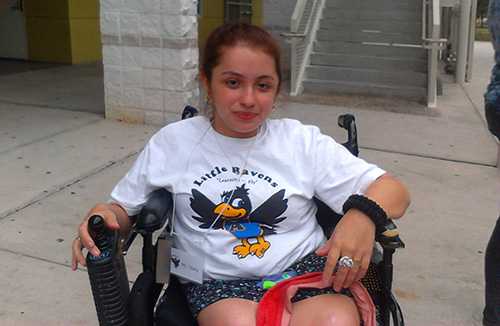
Daily’s Story—In her own words
Daily is an adult living with spina bifida. She shares her story of how she can do anything anyone else can do, she just does it in her own way. Read more below.
My name is Daily, and I am currently 19 years old. I was born with spina bifida. I have had so many surgeries that I have lost count myself. I am currently in a wheelchair. I really don’t consider myself any different than anyone else. I can do everything a walking person can do, just in my own way. When I was born, my mom was told that I wouldn’t make it. And boy, did I prove them wrong. I just recently graduated high school, and I am getting ready to start college. I am so excited. My major is Early Childhood Education.

Eli’s Story—Written by his mom, Jodie
Jodie shares the story of her son Eli, who was born with spina bifida. Upon Eli’s birth, Jodie and her husband learned that he had further health problems, causing him to be on life support. Although Eli was only alive for a short time, he has given his family a lifetime of peace. Read his special story below.
After four years of marriage, we thought we had it all figured out. We had finished college, bought a new home, and we began to start our family. But due to reasons unknown, that served to be quite the challenge for us. Our first pregnancy resulted in painful miscarriage. Then we experienced fertility problems. We assumed adoption would be our fate.
With our last fertility treatment, we achieved success! Several weeks later, our doctor found two healthy beating hearts on the ultrasound screen. However, complications arose very quickly. About midway through, we were given devastating news. We were told that we were having twin boys, but that Twin A had been diagnosed with spina bifida, a neural tube defect. We left our doctor’s office in shock. But after a few days, we began to prepare a place for a special needs twin and his healthy brother. On August 3rd we delivered: Elijah “Eli” Cole 6lbs 3oz & Walker Daniel 5lb 7oz.
As planned, Eli (Twin A) was rushed to the local children’s hospital upon birth for observation by their Spina Bifida Team, and Walker remained with me. Eli’s MRI results were worse than we thought, and he had multiple problems associated with his spina bifida. We learned that if he survived, our baby would never know how to eat, how to speak, or how to breathe on his own for the rest of his life. He would never know us, his parents. We immediately felt a rush of strength that God was preparing us for what was to come. We met with an organ donation organization so Eli might be able to give the gift of life. A representative informed us that Eli’s heart valves could save possibly two other babies. We planned the removal of his ventilator and prepared our entire family to say their goodbyes.
On August 6th, we watched as his ventilator & monitor wires were removed. We were told to only expect minutes with him. But against all odds, Eli kept breathing for fourteen hours. Our doctors encouraged us to transport Eli from the local children’s hospital to the hospital where his twin brother was so that they could be together. Once Eli’s hand was placed onto Walker’s little body, Eli’s color began to return and a slight smirk came across his face. We saw proof of the power of twins. And for the first time, we were finally able to enjoy our Eli, celebrate his life, and mourn peacefully, as a family.
Eli passed away in our arms later that evening, after an amazing 31 hours after his ventilator was removed. Those 31 hours gave us a lifetime of peace. Throughout this journey, we witnessed unbelievable strength, compassion, and the good deeds of friends, family, and medical personnel. We cherish each day we have with Walker and remain in constant awe of God’s plan for our lives.
On August 8th of this year, as we were mourning the 1-year anniversary of Eli’s death that day, we found out we are expecting again. We found out that this miracle baby is a baby girl, whom we have named “Ellie”.
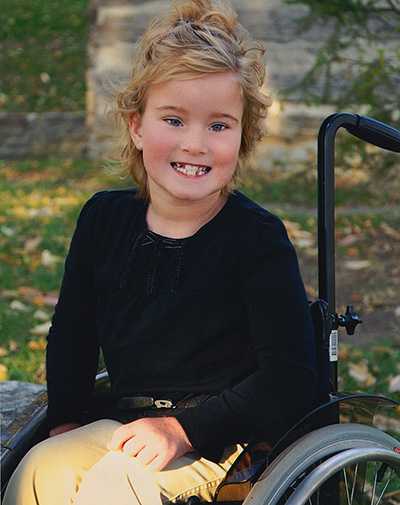
Elley’s Story—Written by her mom, Maryanne
Maryanne shares the story of her daughter, Elley, who was born with spina bifida. While Elley has experienced many challenges, her family has chosen not to allow her disability to determine who she is, but rather what she has to overcome to live life to the fullest. Read more of her story.
I was about 26 weeks pregnant when my O.B. ordered a more detailed ultrasound. It was then that we discovered that our daughter, Elley, had spina bifida (a neural tube birth defect) and also hydrocephalus (excess fluid in the brain), along with several other related diagnoses. That day, my husband and I were given some tough news. But, we knew that God had fearfully and wonderfully created Elley just as she was. And, by His strength and grace, we would do everything we could to give her quality of life. We began seeking any resource possible to prepare us for her birth and the concerns that we may encounter as a result of her spina bifida.
Elley has had such a positive impact on our family. Of course, there are many challenges that can occur with spina bifida. However, we have chosen not to allow her disability to determine who she is, but what she has to overcome to live life to the fullest. Elley is in a wheelchair and that has impacted our family to some degree. We have to make alterations here and there to maneuver her around, but we try to treat her as normal as possible and not make her feel as if she is a burden in any way! We take family vacations and get her out of the house as much as possible. She loves to go to church, and we try to include her in all the activities with her age group.
She has taught us to not let anything get in the way of what you truly want to accomplish in life. Yes, heads turn when a wheelchair rolls into a room, but she uses that attention to force people to talk to her. She is a social butterfly! Elley has an older brother, Luke, and they are best friends. She has impacted his life in many ways. He has had to be very understanding, as we have to extend more time and energy to meeting Elley’s needs. At times it is difficult as parents to balance our time between the two children. We look for ways to do special things with Luke and include him in the tough medical decisions that have had to be made over the last 10 years. He has had to see his sister endure about 17 surgeries in her lifetime and he has been a tremendous support system. Living with a sibling who has special needs has made Luke be more sensitive to other children with special needs at his school, who also may have developmental and learning challenges and delays like his sister.
Elley has impacted us by her sweet and sensitive spirit. She is extremely brave and although she has times of anxiety about the unknowns that may be facing her, she presses on with a courageous heart. Elley has taught us the importance of counting every victory and being thankful for every day that we are given.
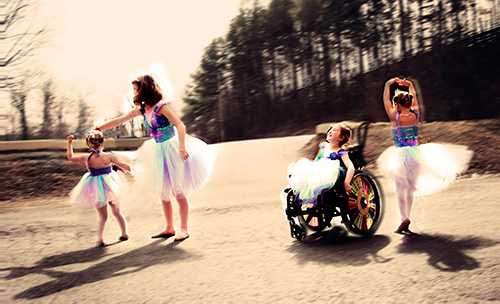
Katie’s Story
Katie was born with spina bifida. Although she has faced challenges, nothing holds her back. Her mother shares, “there is nothing she has wanted to do, that we haven’t been able to get her to do with some modifications.” Read more of her uplifting story below.
At 19 weeks of her second pregnancy, Julie and her husband, Andy, were excited because they were having an ultrasound to learn the sex of their second child. They never imagined the test would reveal anything more dramatic; however, they were told their baby would be born with spina bifida.
Their daughter, Katie, was born December 26, 2001. She is now 10 years old and has enjoyed “dancing” with the help of her wheelchair since the age of three, inspiring other children with disabilities to dance as well. Katie is a straight “A” student who also plays baseball, soccer, takes music classes, sings in the church choir, and goes to a spina bifida camp each summer. “There is nothing she has wanted to do, that we haven’t been able to get her to do with some modifications,” says Julie.
“Do I wish she did not have spina bifida and could run and play like other children? Yes. Life is tough for her. Simple things like pulling up her own pants can take a half-hour. She has had 15 surgeries and numerous hospitalizations because of infections,” says Julie. “But our family has learned to appreciate the small things in life more. She has been a blessing to our family.”
“I encourage other women to take 400 micrograms of folic acid if you are able to get pregnant, even if you are not planning a pregnancy. Studies have shown that it can help prevent spina bifida in many cases,” said Julie. “If you’ve already had a child with a neural tube defect, it is recommended you take 4,000 micrograms of folic acid. That’s what I did, and my next two children were not born with spina bifida.”
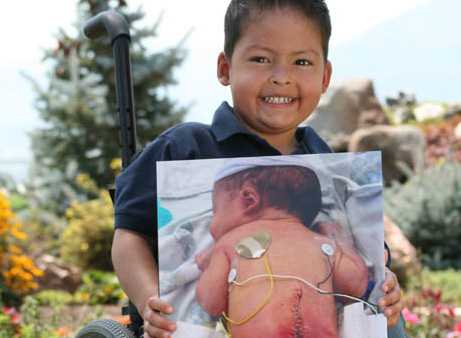
Zachary’s Story – Written by his mom, Amanda
Amanda found out at 32 weeks pregnant that her third child, Zachary, would be born with spina bifida. Although the family was unsure and afraid of what the future held, they also felt hope. Zachary has a strong spirit and by no means has a “poor quality of life”. He is an inspiration to everyone around him.
I had two very active boys, two years and eight months old, when I found out I was four months pregnant, and that I was having another boy. It took me a long time to be happy about the pregnancy. I was 32 weeks along when we found out that our baby would be born with spina bifida. We were told that it was a very serious condition, that he would not walk, that he would have many other problems, and that he would have a “poor quality of life.” We left feeling unsure and afraid, yet we also felt hope and knew that somehow, everything would be okay.
Zachary was delivered at 37 weeks, as soon as his lungs were ready. Within 24 hours, he had surgery to close the hole on his back and two days later, he had surgery to have a shunt, or tube, placed in his brain to drain the excess fluid into his abdominal cavity. He did very well and was only in the hospital five days. At ten months old, he had to have his shunt replaced. He recently had surgery to stretch the muscles and tendons in his hips and ankles, allowing his legs to straighten out all the way. Zachary can’t walk, but thanks to amazing therapists, he is very strong and mobile in his own way. He likes to show-off in his wheelchair and “run” as fast as he can in it. He has had and will have many challenges and disappointments, but that is part of life for all of us. He has a strong spirit and by no means has a “poor quality of life.” He is our hero and our inspiration and we love him and his brothers so much.
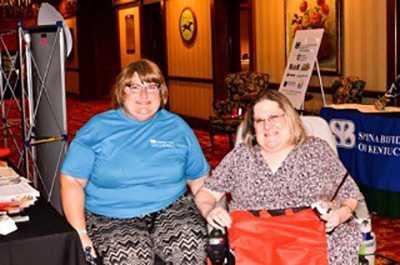
Beth’s Story—In her own words
People living with a birth defect like spina bifida can face many challenges, like numerous surgeries. Read Beth’s story to see how she overcame these challenges and leads a full life with spina bifida.
My name is Beth Bryant. I am a 45-year old adult with spina bifida. I was born at a time when only 10% of babies born with spina bifida survived. Growing up wasn’t easy. I had many surgeries over the years. I had to wear special shoes and leg braces, and I often felt like an outcast. Despite these challenges, I have always been active to keep up with my peers.
After having many surgeries over the years, in 1995 I had my first tethered cord surgery on my back. Many people with spina bifida have tethered spinal cords. Normally, the bottom of the spinal cord floats around freely in the spinal canal. A tethered spinal cord is attached to the spinal canal. When this happens, the spinal cord can stretch as a person grows and can cause damage to spinal nerves. Surgery can help treat it. During my surgery, the doctor also had to remove a cancerous cyst. Fortunately, he was able to safely remove it and all the cancer.
After the surgery, I had to retrain my brain to learn to walk again. My biggest challenge came when I once again had to have tethered cord surgery with a removal of a cyst. I didn’t bounce back quite like I had the first time. This surgery left me using a wheelchair during most of my day. When I woke up from this 2nd tethered cord surgery, I could not feel anything from my waist down. After a very long recovery, I did eventually regain some feeling, but not enough to use a walker for very long.
Despite numerous surgeries and challenges, I do live a very full life. I volunteer for the Spina Bifida Association of Kentucky and with my church as well. I am very active in adaptive sports, including hand cycling, wheelchair basketball, and rowing. I also zip around in my wheelchair to get around in my community. I feel like I have a very positive outlook on life. Without the struggles in my life, I would not have the strength that I have.
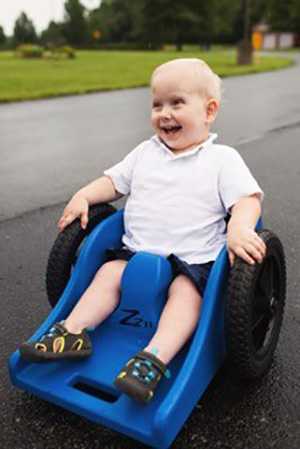
Henry’s story-Written by his mom, Erin
Living with a birth defect can be a challenge, but it doesn’t define one’s life. That is certainly true for Henry, who was born with spina bifida. As his mother, Erin, says, “spina bifida is what Henry has—it will never define who he is.” Read about Henry’s unwavering spirit and fun-loving personality below.
On October 25, 2012 we heard the words “spina bifida” for the first time related to our unborn son, Henry. A doctor began to lay out all the things that Henry would never be. We were told he would never walk, he would never go to a “real school,” he wouldn’t be a normal kid. They told us that as a result of having spina bifida, his life would be hard, and he would likely suffer because of it.
We had no idea what to expect. We had never met anyone with spina bifida, so we did exactly what you are not supposed to do—we googled it. That’s when we found the Spina Bifida Association of Kentucky. They invited us to a play group, and we met kids with spina bifida. The kids were doing all the things that, just a few weeks earlier, doctors said Henry would never do. We learned a lot about Henry that day. Even though we hadn’t met him yet, we learned that spina bifida is what Henry has – it will never define who he is.
Henry is almost 3 now and while things haven’t always been easy, he has proven doctors wrong time and time again. He isn’t walking yet, but he gets closer every day with lots of practice and the help of an amazing therapy team. But Henry has shown us that life isn’t lived only by those who are able to walk. He has shown us with unwavering spirit and determination that if you want something, you go get it, and you use what you have to get there.
Henry is probably the happiest person I have ever met. Through every surgery or medical test, he braces life with a smile as wide as Texas. He does all the things “normal” almost 3-year-olds do. He loves macaroni and cheese. He is always up for a ride in the wagon. His favorite color is yellow, and he laughs hysterically when he sees someone fall! He loves exploring the world around him in his ZipZac, and he can zip that thing around faster than I can walk sometimes.
Yes, Henry has spina bifida, but it’s never going to be the coolest thing about him. He is able to live a life full of smiles, adventures, the very best giggles, and the ability to adapt where he needs to.
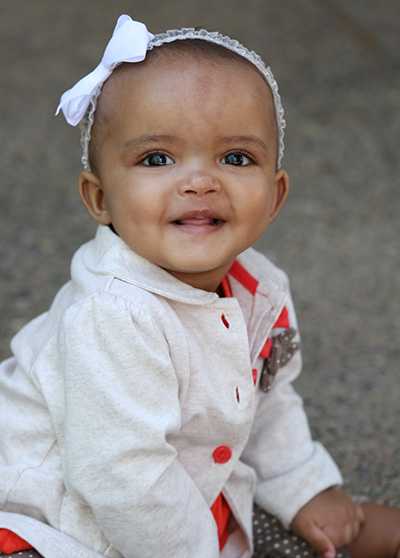
Renee’s Story-Written by her mom, Venesha
A birth defect diagnosis can be difficult to comprehend and prepare for. Venesha felt shocked when her daughter, Renee, was diagnosed with spina bifida shortly after birth. Read about how Venesha moved forward after the diagnosis and learned how to best care for Renee, who has become a fearless little girl who doesn’t let spina bifida define her.
When I was pregnant with Renee, I had a near perfect pregnancy despite some sharp pains in my lower belly every so often. I delivered Renee via a scheduled C-section at 39 weeks. During the delivery, I remember seeing her face. And then I remember noticing something odd and thought, “wait, what’s that bump on her back?” It looked like an extra rump on her bottom. The doctor said it was probably a collection of blood vessels and that the bump would likely go down.
The next day, the doctor did some tests to look at her spine. He told us he thought it was spina bifida. My first thought was, “Spina what?” I had never heard of spina bifida before. The doctor said that Renee needed to be transferred to the NICU (Neonatal Intensive Care Unit) at a hospital across town to see a neurosurgeon. I was shocked. A neurosurgeon! I couldn’t understand it. I had received both genetic testing and several ultrasounds. How could this have gone undetected?
After Renee’s diagnosis, I was left to my own anxiety. I searched the internet for more information about spina bifida. Some of the images that I found were hard to look at. I read about all of the possible side effects and challenges that Renee would have to endure. I managed to find an image showing different types of spina bifida and decided Renee’s type looked like lipomyelomeningocele.
It is a terrible feeling to have your two-day-old infant taken from your arms and placed in a traveling incubator box. Luckily, I was able to be transferred to the new hospital as well. I met with the neurosurgeon and he tried to explain everything to us. I asked flatly, “Is it lipomyelomeningocele?” Surprised, he replied, “Umm, yes, that is the Latin term for it.” Once we had that out in the open, I wanted to know what to expect. Renee spent a week in the NICU having additional tests. During that time, the nurses trained me on how to use a catheter, which is a tube inserted in the bladder that can help drain her urine. Renee must not have liked that, because after the second time, if we even got near her with the catheter, she’d pee.
Despite her diagnosis, the only issue Renee had after her surgery to fix her spine was foot drop (inability to lift the front part of the foot). Now, we are working to rehabilitate her foot. She continues to succeed despite her challenges with spina bifida. She loves to cruise the furniture and dance. We recently celebrated her first birthday. We believe that while she has spina bifida, it does not have her; it does not define her. She’s a firecracker—so determined and fearless.
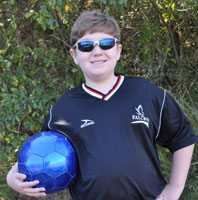
Clark’s Story—Written by his mom, Nancy
Nancy shares the story of her son Clark, who was born with spina bifida. Although spina bifida impacts his life every day, Clark does not let it define who he is. Read his story below.
Nancy went for her five-month ultrasound to find out whether she was expecting a boy or a girl. “They kept repeating the ultrasound over and over. I knew from a mother’s instinct, and from being a nurse, that something was wrong. The doctor walked in and said your son’s going to have spina bifida. I had briefly studied spina bifida in nursing school, only hearing about the worst-case scenarios, so immediately I thought that’s what my child would be facing.”
Nancy was referred to a high risk obstetrician and the spina bifida clinic at Children’s Hospital of Alabama in Birmingham. At her prenatal consultation in the clinic she went with questions about her son’s prognosis. “The pediatric neurosurgeon told me to put away all my questions and said I don’t know, I don’t know.” Nancy and her husband were very scared and shaken.
Nancy shares that the staff at Children’s Hospital were wonderful, “…but the lack of research when Clark was born meant there were so many ‘don’t knows.’ It would have been so helpful to have a better roadmap based on research. More spina bifida research would give parents definite steps to take at each milestone to ensure the best results for their child. It would also help manage the secondary conditions. Every issue is just as important as the next. Some families might deal more with neurological symptoms, while others struggle daily with bowel and bladder concerns. Nutrition and physical activity are also important when it comes to living with the condition. Clark is ambulatory and goes to the gym but it’s still very difficult for him to get his heart rate up. I’m constantly watching his weight. For us, the closest accessible sports are an hour and fifteen minutes away. There are not enough resources available.”
Clark loves watching college football and he’s the assistant coach of his younger brother’s soccer team. He likes to hang out with his friends. Although spina bifida impacts his life every day, Clark does not let it define who he is.
Anifa’s Story
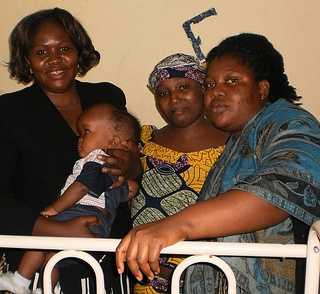
Anifa is an 18 month old boy with spina bifida who lives in Nigeria. In the United States, children born with spina bifida often live long and productive lives, even though they face many challenges. In many other countries it is a more difficult road. Read about some Anifa’s challenges.
Anifa is an 18 month old boy who lives in Nigeria. Anifa was born with spina bifida. Like most children with spina bifida, Anifa has no movement of his legs (he is paralyzed) and he has no bowel and bladder control. He works very hard just trying to crawl on his chest.
Anifa lives with his family in a village where there is no primary health center. His mother does not own a stroller and cannot buy diapers. She has to use leaves and paper to keep him clean. She and her husband are doing everything they can for their child, but without proper care, the reality is that Anifa’s future is uncertain.
Anifa had to wait until he was nine months old before he had his first back surgery to close the opening in his spine. Imagine that for nine months his spinal cord was exposed, without protection. In the United States, the first surgery for a baby born with spina bifida usually takes place within the first 24 hours of life to avoid infection, other complications, or death. But Anifa had no choice but to wait.
Anifa will likely face lifelong medical challenges associated with his spina bifida, and the financial and emotional impacts that his family will endure are overwhelming. In the United States, children born with spina bifida often live long and productive lives, even though they face many challenges. But, in many other countries, the outlook for children like Anifa is not as positive.
- Page last reviewed: November 7, 2016
- Page last updated: July 28, 2017
- Content source:



 ShareCompartir
ShareCompartir